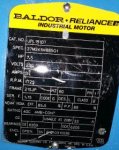Coppersmith
Senior Member
- Location
- Tampa, FL, USA
- Occupation
- Electrical Contractor
Here is the data plate for a motor I hooked up. (It powers a waterfall feature in an artificial mountain behind a large residence. Gotta love rich people.) I'm told it's the same size motor as one that burned up. The existing breaker was a 2-pole 40 amp @ 240v. The wiring is #6 THHN/THWN. The motor tripped the breaker after about 15 seconds. (Tried several times.) I looked up the calculations and if I am correct it should be a 70 amp breaker. Note that the data plate says "31 amps" and not "31 FLA". I assumed they were the same thing. I installed the 70, the motor ran about 2 minutes and then started to smoke. I flipped off the breaker. The breaker was very warm and the handle was squishy. After the breaker cooled for a few minutes, it appeared to operate with it's normal feel. There is no motor starter or heaters in the circuit.
1) Is 70 amps correct?
2) Why would the breaker handle get squishy? It's a SqD QO.
3) Is there an electrical issue here (beside the breaker size)? I personally think the flow is obstructed causing excessive motor loading. I suggested to the owner he call the plumber back (who installed the motor) to check for obstructions.
4) I also suggested that if there is no obstruction, a call to a motor repair specialist would be in order to check the motor for proper operation. Was this a good call?
5) Should there be a DOL motor starter with heaters in the circuit or it it OK without heaters?
1) Is 70 amps correct?
2) Why would the breaker handle get squishy? It's a SqD QO.
3) Is there an electrical issue here (beside the breaker size)? I personally think the flow is obstructed causing excessive motor loading. I suggested to the owner he call the plumber back (who installed the motor) to check for obstructions.
4) I also suggested that if there is no obstruction, a call to a motor repair specialist would be in order to check the motor for proper operation. Was this a good call?
5) Should there be a DOL motor starter with heaters in the circuit or it it OK without heaters?

